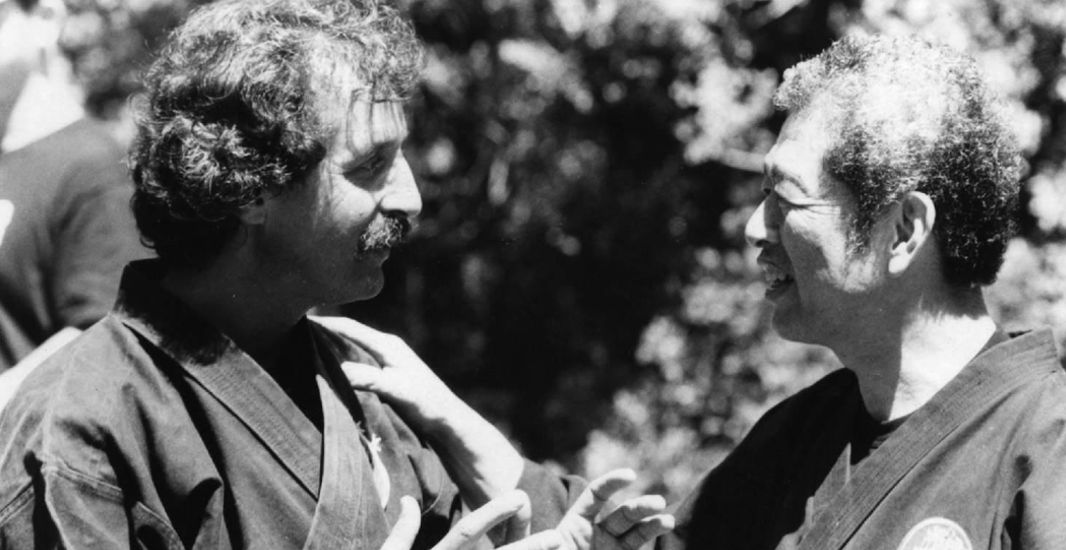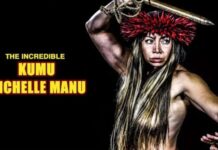A narrow path leads from the main road to the house of Tanemura Shihan, one of the master teachers of the ancient art of ninjutsu. Rice fields, cut not long ago, surround the house in Matsubushi Mura, a village only two hours away from Tokyo.
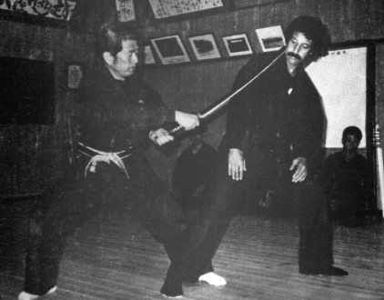
In the dojo, at the house, all are silent. The Grandmaster, Dr. Masaaki Hatsumi, takes a sword that hangs on the wall. “Doron-kun, ” he orders his Israeli student. “Sit in front of me.”
Everyone knew what was going to happen for Doron Navon’s Godan Test. The first non Japanese to learn Togakure Ryu ninjutsu, was about to go through the “Test of Truth”. About 10 of Hatsumi Sensei’s top students were at the dojo; some of the most prestigious names in modern ninjutsu. All of them had at one time or another been through the same test.
Doron Navon’s Godan Test, The Test of Truth, if passed would give him his 5th dan (godan) rank in ninjutsu. The Test of Truth differs from tests of similar rank in most other martial arts. The student sits in seiza with his back to the grandmaster. The grandmaster raises his sword above his own head, and then, all of a sudden, without warning, strikes swiftly at the head of his student. Only a split second separates the student and the deadly blow. In ancient days, it is alleged, a real sword was used. If the student could sense the sword coming and elude it, he made godan. If not . . .
Today a bokken (wooden sword) is used, but the blow is horribly painful nonetheless; and the student’s head is uncovered. Until this particular evening, only five of Hatsumi Sensei’s students had passed the test on their first attempt. The others, also few, have felt the sword once, twice, some even three times before gaining acceptance onto that hallowed level of achievement. The senior students were alert, hushed. This was the first time in which a non Japanese would be tested. The five shihan (master teachers) knew Doron well; he had been their training companion nine years before. At that time, after eight years in Japan, six with Hatsumi Sensei, Doron returned to his hometown in Israel and opened his own dojo. He still continued to study and practice, however, to reflect and absorb the immense wealth of knowledge Hatsumi Senses had bestowed on him. There was an awful lot to remember.
And then one day in October 1983, the urge to return became stronger, almost unbearable. Doron and I were soon on our way back to his ninjutsu roots. He had not told Hatsumi Sensei we were coming. We simply arrived one day at his house. It was evening time in Noda city, Chiba prefecture, Japan. People were on their way home after a day’s work. Doron and I went to Hatsumi Sensei’s house, only a 10 minute walk from the train station, just off the main street.
It looked as if nothing had changed for nine years. The bicycles were parked outside. The sliding door was open. A few pairs of slippers on the right. A few pairs of shoes.
“Sensei?” The question barely touched the air and Hatsumi Masaaki was already at the door. “Hai. ” (Yes.) He looked at his visitors. “Oksan, ” he called to his wife Mariko-san, “Doron-san has arrived.” Like a storm she came from their living quarters on the second floor. “Doron-san, ” she cried, unable to hold back her tears of joy. She came to embrace him, but a bit shy, she just shook his hands continuously, looking at him, as if to make sure it really was Doron. Hatsumi Sensei smiled at the scene. He was very happy. A lost son had come back. For Hatsumi Sensei it was not as if nine years had passed, but only one day. He looked at his Israeli student, who had just arrived from the other side of the globe, as if it was natural for him to come like that. With no further small talk, he went straight ahead leading a conversation that was cut years ago. For him nothing was really strange about a son returning home after years of absence.
Doron had recalled for me his first meeting with Hatsumi Sensei in the early `60s. “We heard about him,” he said, “while we attended the Kodokan for judo training. One day my friend Danny told me he had seen this master who used vicious techniques. He showed me some; and they were so different from anything I’d seen before. I urged him to take me there the same evening.”
Danny and Doron went straight to Noda city and arrived at the house. “The door was open but we knocked anyway. `Hello’, he said to us, seeing two gai-jin (non-Japanese, foreigners). We already spoke Japanese, after two years in Japan, and asked him whether we could get in and join the training session. He didn’t say yes or no, but showed us the way in. I remember every minute from that moment on. Each minute for each pain. There were five senior students at the dojo, all wearing black belts on black gis. He gave a sign and two of them stopped what they were doing and came to welcome us.
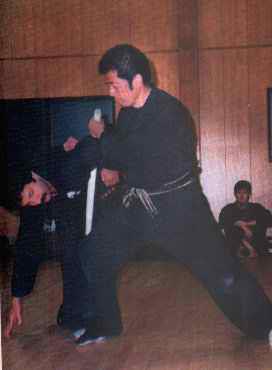 It was an unforgettable welcome. The two Israeli guests received a personal treatment which left marks on them for many days later. The two senior students played with them as if they were dolls, and each time they tried to resist, there was a countermove ready for them to hurt even more. On their way back home later that evening, they licked their wounds; but the next day they came again. They understood it was a world they never knew before, the real Budo. They came, were persistent, and Hatsumi Masaaki admitted them to his school.
It was an unforgettable welcome. The two Israeli guests received a personal treatment which left marks on them for many days later. The two senior students played with them as if they were dolls, and each time they tried to resist, there was a countermove ready for them to hurt even more. On their way back home later that evening, they licked their wounds; but the next day they came again. They understood it was a world they never knew before, the real Budo. They came, were persistent, and Hatsumi Masaaki admitted them to his school.
At first they were carefully looked at. True knowledge was not given away easily. Only when Hatsumi saw they were serious students did he begin to reveal the real art to them. They were the first non Japanese to become regular students in the Bujin Kan Dojo. A few westerners had visited Hatsumi before them, but none of those had become real ninjutsu students.
In classes they worked on the basic movements, the kihon happo: Drills of kicks and blocks and punches, arm locks, arm breaks, body breaks. Only a few advanced techniques were used. Most were kept secret and taught only on a person to person level. The ominous swords just hung there on the wall, ready to be used on the third level.
But this was not play. Hatsumi Sensei was at the saki period of his training, using killing techniques more than anything else. A student at that time had to know before he entered the class that training might also mean death. Nobody died, but still there was this commitment in the air and the techniques were executed almost to the full.
Injuries were very common. “One day I broke my tailbone,” recalls Doron. “But I didn’t stop training; and I kept coming to class, with a pillow tied to my behind. Everybody thought it was so funny.
“But Hatsumi thought my injury was a good opportunity. He called me up front to test me for my nidan. It was always like this. He always tested us the moment we were not ready for it. Once, I had a high temperature; a second time with my tailbone broken; a third time when I had a cast on my left hand after I broke my arm the previous lesson. But we had to do our best fighting, demonstrating our abilities with all the inconveniences.
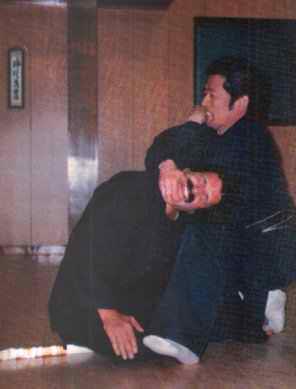 “I was really crazy at the time,” says Doron. “I was training for six to eight hours a day. After each lesson I went to train with one of the shihans, each of them teaching me something different. To sum it all up, Hatsumi Sensei was teaching me as much as I could absorb. One day I felt I’d had enough. My body was a wreck from all those unavoidable injuries and my mind was full of so many techniques that I had to stop.” In 1974, after eight years in Japan, Doron received his yondan rank and a teaching permit. He then returned to Israel and started his own dojo. The art was all in his head but he needed more practice to refine the movements and the ideas. The first Israeli students that joined Doron’s dojo were not the most lucky. They had to cope with training in a very similar way to the saki time Doron had been through in Japan. But soon enough a group of devoted students became a nucleus of the Israeli Ninja school. Some of them eventually went to Japan to train with Hatsumi Sensei and the shihan master teachers of Togakure Ryu.
“I was really crazy at the time,” says Doron. “I was training for six to eight hours a day. After each lesson I went to train with one of the shihans, each of them teaching me something different. To sum it all up, Hatsumi Sensei was teaching me as much as I could absorb. One day I felt I’d had enough. My body was a wreck from all those unavoidable injuries and my mind was full of so many techniques that I had to stop.” In 1974, after eight years in Japan, Doron received his yondan rank and a teaching permit. He then returned to Israel and started his own dojo. The art was all in his head but he needed more practice to refine the movements and the ideas. The first Israeli students that joined Doron’s dojo were not the most lucky. They had to cope with training in a very similar way to the saki time Doron had been through in Japan. But soon enough a group of devoted students became a nucleus of the Israeli Ninja school. Some of them eventually went to Japan to train with Hatsumi Sensei and the shihan master teachers of Togakure Ryu.
“The most important thing for me is to keep on learning, practicing and teaching,” says Doron. “Life is a continuous and changing thing and I must keep on going, moving with the rhythm of life, not pretending to be something I’m not. A real martial artist must know himself in order to see life in a clear way.”
The way for Doron, now that he was back with Hatsumi Sensei, seemed clear enough. Hatsumi, however, had a surprise in store for him. He quickly arranged a “small gathering . . . just for old times’ sake” with Doron’s companions of years ago. Perhaps they would “practice a little. . . ” Hatsumi smiled. Moments later we were on our way to Tanemura Shihan’s house.
Once there, there was much greeting and handshaking all around, and the recalling of many wonderful memories. And then Hatsumi Sensei suddenly turned to Doron and asked, “Do you want to take your godan exam?”
Doron was momentarily flustered, so totally unexpected was the question. But then he composed himself, shrugged and smiled, “Why not?”
Ordinarily a non-student would not be allowed to witness this very private ceremonious event; but since I was Doron’s student and had traveled with him all the way from Israel, Hatsumi Sensei made the exception. I sat quietly down in a corner, excited, yet restrained, perhaps a little nervous. It seemed that history of a sort was in the making. Hatsumi softly instructed Doron to sit in seiza, then stepped behind him. In an instant Doron jumped up, still a little flustered, perhaps just a little nervous himself. Hatsumi laughed and said, “But I haven’t even started yet.” And then Doron sat down again and relaxed, his body slowly unwinding, untensing, letting go . . . .
Hatsumi stood ready, his sword upraised, his eyes closed. Doron sat at his feet, his back to him, motionless, waiting. Suddenly Hatsumi stroked. The sword sped down toward Doron’s head. In the same instant, it was as if someone had pulled Doron aside. He rolled to his right and the sword sliced past, reaching the point where Doron’s stomach had been only a moment before. Hatsumi’s eyes were still closed. He affirmed his hold on the sword and opened his eyes. “Hai!” (Yes!), he said. “Godan. ” (Fifth dan) .
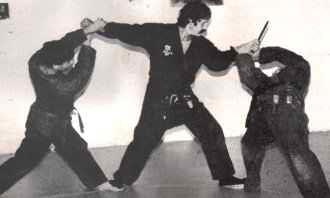 I was sitting in the corner not believing my own eyes. Hatsumi Sensei turned to me, pointed at Doron, and said: “Mites!” (You saw that!). “Now tell everybody.”
I was sitting in the corner not believing my own eyes. Hatsumi Sensei turned to me, pointed at Doron, and said: “Mites!” (You saw that!). “Now tell everybody.”
Doron’s Japanese friends could not contain their joy. They rushed to him, shook his hand warmly, excitedly, laughing and shouting. There was no denying how happy they were for him.
Doron himself hadn’t yet realized what he’d just been through. Only a few days later did he understand the significance of his personal achievement. Hatsumi Sensei presented him with a gold medal he had prepared many years ago to award the first non Japanese student who could pass the test on his first attempt. It had taken more than five years to give the medal away.
“Homono Shidoshi,” Hatsumi Sensei called him. A true teacher; a title that accompanies the test and the new rank outside Japan. Doron Navon is the first, and so far, the only non Japanese to hold it. He has since earned his rokudan, the highest rank in the West and, as he puts it, “this is only the beginning.” Even in Japan there are only a few Homono Shidoshi. Since the late 1960s, when the art of ninjutsu came out of the shadows, there have not been that many who came to study the art with total commitment and full dedication. The study of ninjutsu requires many, many years of hard work; training and more training, over and over again. Grandmaster Hatsumi says it took him some 40 years to acquire the ability he has now; and he still keeps going.
At 56, Hatsumi Sensei doesn’t rely on strength and muscles to get the job done. “If your technique is based on strength, some day a young bull will come and beat you with fresh muscles,” he says.
The art that Hatsumi Sensei practices has a character of “no power”. The nagare (flow) of his movement has no resistance whatever. “If you feel you use strength against your opponent,” Hatsumi says, “it means you are not exercising the real art.”
This does not mean that Hatsumi Sensei is powerless; on the contrary: He masters the art in a way that has no rival, not even among the younger students who have practiced under him for more than 20 years. Says one ninjutsu shihan who knows Hatsumi well: “He always has another rabbit in his hat. And he also has many hats . . .
(Editor’s Note:) Recently, Doron Navon stopped by our New York offices on his way to Toronto, Canada to attend a seminar. We talked about his years with Hatsumi, specifically about his “Test of Truth.” Doron explained that godan is a very special stage of ninjutsu training. It is highly advanced. The first four belt levels are a significant part of the process, but they mainly emphasize the physical aspects: taijutsu, the techniques, the weapons etc. From the beginning, however, the student is evolving, always experiencing a higher level of understanding, until the senses become acute. When the instructor sees that the student is becoming more aware of himself, his senses, his instincts, his intuition, he knows then that he is ready. Everything then culminates in the exam for godan . . . the Test of Truth.”
As for his own exam, Doron Navon recalled: “After I jumped up the first time, I got myself together, then sat down again in seizes. Before, I was tense, tight. This time I just let myself go, finally achieving jibun o sutera (letting go of one’s self, one’s ego). But the really strange thing is, I could not remember anything that happened from that moment on until I felt myself off to one side, looking at Hatsumi Sensei and seeing the sword passing within an inch of my body. It was as though it was all in slow motion. Of course I was told later what really had happened: that the sword was not coming down in slow motion at all; that it had looked as though I had been jerked aside by some force… But all I remember is seeing the sword passing slowly by. “What was even more interesting to me,” Doron smiled, “was that Hatsumi Sensei had told the others, without my hearing it, that he `knew’ I would pass the test. Even then, they all gasped in astonishment. It pleases me to know Hatsumi Sensei had that much confidence in me.” Apparently it was a Test of Truth for both student and master. And both passed with flying colors.

